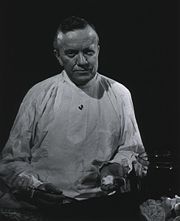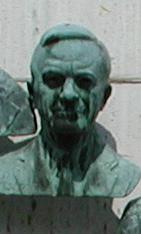.gif)
Charles Armstrong (physician)
Encyclopedia

Lymphocytic choriomeningitis
Lymphocytic choriomeningitis , is a rodent-borne viral infectious disease that presents as aseptic meningitis, encephalitis or meningoencephalitis. Its causative agent is the Lymphocytic Choriomeningitis Virus , a member of the family Arenaviridae...
in 1934 after isolating the hitherto completely unknown virus. He discovered in 1939 that poliovirus
Poliovirus
Poliovirus, the causative agent of poliomyelitis, is a human enterovirus and member of the family of Picornaviridae.Poliovirus is composed of an RNA genome and a protein capsid. The genome is a single-stranded positive-sense RNA genome that is about 7500 nucleotides long. The viral particle is...
can be transmitted to cotton rats, and started self-tests with nasal spray vaccination.
Education
In 1905 Charles Armstrong graduated from Alliance High School and went on toMount Union College Preparatory School from 1905–1906. He took a B.S. degree from Mount Union College
Mount Union College
The University of Mount Union is a 4-year private, coeducational, liberal arts college in Alliance, Ohio.Mount Union enrolls 2200 undergraduates. Approximately 50 percent are women and 50 percent are men, representing more than 22 states and 13 countries. Mount Union has an active alumni base of...
, Alliance, Ohio in 1910. In 1915 he graduated from Johns Hopkins Medical School, with an M.D. degree and did a General Internship at Yale-New Haven Hospital
Yale-New Haven Hospital
Yale-New Haven Hospital , Connecticut's largest hospital with 966 beds, is located in New Haven, Connecticut.The hospital is owned and operated by the Yale New Haven Health System, Inc...
until 1916.
Civilian career
On October 16, 1916, he was commissioned to the U.S. Public Health Service and served for six weeks at the Immigration Station, Ellis IslandEllis Island
Ellis Island in New York Harbor was the gateway for millions of immigrants to the United States. It was the nation's busiest immigrant inspection station from 1892 until 1954. The island was greatly expanded with landfill between 1892 and 1934. Before that, the much smaller original island was the...
, New York. From November 1916 to September 1918, he was Medical Officer on the United States Coast Guard Cutter (CSG) Seneca
USCGC Seneca (1908)
USCGC Seneca had an interesting and varied history. Fighting submarines in World War I, making the International Ice Patrol, capturing rum runners in the Prohibition era, saving lives from Greenland to Puerto Rico, from Gibraltar to the Gulf of Mexico, participating in colorful ceremonies and...
assigned to Cuban and European waters for 17 months until the ship was transferred to the U.S. Navy during World War I.
When in the fall of 1918 local outbreaks of pandemic influenza
Influenza
Influenza, commonly referred to as the flu, is an infectious disease caused by RNA viruses of the family Orthomyxoviridae , that affects birds and mammals...
occurred, Armstrong was a member of the investigating team. From 1919 to 1921, he worked as an Epidemiological Aide to the Ohio State Department of Health. For the next decades, from 1921 until his retirement from active duty in 1950 he worked at the Hygienic Laboratory, remaining there through its administrative and name changes to the National Institutes of Health
National Institutes of Health
The National Institutes of Health are an agency of the United States Department of Health and Human Services and are the primary agency of the United States government responsible for biomedical and health-related research. Its science and engineering counterpart is the National Science Foundation...
. From 1950 to 1963, Armstrong continued at the Institute, doing daily research work without compensation.
Armstrong was married to Elizabeth Alberta Rich from 1920 till his death. He had one daughter Mary Emma (*1924).
Virological research
Armstrong's world wide recognition as a virologist is due (a) to his discovery, in 1934, of the virus that is the agent in a clinical entity, which he named lymphocytic choriomeningitis (LCM) and (b) to his successful work in polio research and polio prevention.LCM
In 1934 Armstrong isolated a previously undescribed neurotropic virus found during the experimental transmission of encephalitis virus from the 1933 St. Louis epidemicSt. Louis Encephalitis
St. Louis Encephalitis is a disease caused by the Culex mosquito borne St. Louis Encephalitis virus. St. Louis encephalitis virus is related to Japanese encephalitis virus and is a member of the Flaviviridae subgroup. This disease mainly affects the United States...
from which it was differentiated and he demonstrated the virus in the central nervous system, spinal fluid, blood and urine of monkeys and in the brain and blood of mice during the experimental disease.
In the majority of the monkeys there was more or less diffuse and irregular cellular infiltration
Cellular infiltration
Cellular infiltration is migration of cells from their sources of origin, or direct extension of cells as a result of unusual growth and multiplication, thereby resulting in fairly well-defined foci, irregular accumulations, or diffusely distributed individual cells in the connective tissue and...
of the meninges
Meninges
The meninges is the system of membranes which envelopes the central nervous system. The meninges consist of three layers: the dura mater, the arachnoid mater, and the pia mater. The primary function of the meninges and of the cerebrospinal fluid is to protect the central nervous system.-Dura...
.In most animals there was a more or less pronounced swelling, edema and lymphocytic infiltration of the choroid plexus
Choroid plexus
The choroid plexus is a structure in the ventricles of the brain where cerebrospinal fluid is produced...
,i.e. the cellular membrane lining the intracerebral ventricles
Ventricular system
The ventricular system is a set of structures containing cerebrospinal fluid in the brain. It is continuous with the central canal of the spinal cord.-Components:The system comprises four ventricles:* right and left lateral ventricles* third ventricle...
, which led him to name the disease lymphocytic choriomeningitis.
Polio

Cotton rat
A cotton rat is any member of the rodent genus Sigmodon. They are called cotton rats because they build their nests out of cotton, and can damage cotton crops. Cotton rats have small ears and dark coats, and are found in North and South America....
(Sigmodon hispidus hispidus) and then to white mice
Mouse
A mouse is a small mammal belonging to the order of rodents. The best known mouse species is the common house mouse . It is also a popular pet. In some places, certain kinds of field mice are also common. This rodent is eaten by large birds such as hawks and eagles...
. This accomplishment was revolutionary as it made possible the study of many aspects of infection and immunity in humans that could scarcely have been carried out with monkeys. The discovery also stimulated the renewal of efforts to adapt and establish the other immunologic types of poliomyelitis, leading to methods that resulted in the eventual developments of successful vaccines for poliomyelitis.
In recognition of his achievements in polio research and prevention Armstrong was inducted into the Polio Hall of Fame in Warm Springs, Georgia.
Honors
- 1933 Honorary Doctor of Science Degree, Mount Union College; Alliance, Ohio
- 1934 The French scientific community honoured Armstrong by naming the clinical entity, which he had labelled lymphocytic choriomeningitis, “La Maladie d’Armstrong”.
- 1938-9 Appointment to General Advisory Committee of the National Foundation for Infantile Paralysis
- 1944 Election into the National Academy of SciencesUnited States National Academy of SciencesThe National Academy of Sciences is a corporation in the United States whose members serve pro bono as "advisers to the nation on science, engineering, and medicine." As a national academy, new members of the organization are elected annually by current members, based on their distinguished and...
; member in section 10 (PathologyPathologyPathology is the precise study and diagnosis of disease. The word pathology is from Ancient Greek , pathos, "feeling, suffering"; and , -logia, "the study of". Pathologization, to pathologize, refers to the process of defining a condition or behavior as pathological, e.g. pathological gambling....
and BacteriologyBacteriologyBacteriology is the study of bacteria. This subdivision of microbiology involves the identification, classification, and characterization of bacterial species...
) - 1956 Election to the Polio Hall of FamePolio Hall of FameThe Polio Hall of Fame consists of a linear grouping of sculptured busts of fifteen scientists and two laymen who made important contributions to the knowledge and treatment of poliomyelitis...
, which was dedicated in Warm Springs, GeorgiaWarm Springs, GeorgiaWarm Springs is a city in Meriwether County, Georgia, United States. The population was 478 at the 2010 census.-History:Warm Springs first came to prominence in the 19th century as a spa town, due to its mineral springs which flow constantly at nearly 32 °C...
on January 2, 1958 - 1966 Presentation of Distinguished Alumnus Award to Armstrong (and others) by the Alliance High School, Alliance, Ohio
- 1966 Letter of congratulation on his 80th birthday from President Lyndon B. JohnsonLyndon B. JohnsonLyndon Baines Johnson , often referred to as LBJ, was the 36th President of the United States after his service as the 37th Vice President of the United States...
Further reading
The article is mainly based on the Beeman publication, which also contains valuable photos:- Edward A. Beeman: Charles Armstrong, M.D.: A Biography, 2007 also online here (PDF)
- John R. Paul: A History of Poliomyelitis. Yale University Press, New Haven u.a. (Connecticut/USA) 1971 (= Yale studies in the history of science and medicine, 6), ISBN 0-300-01324-8, pp. 270–278

